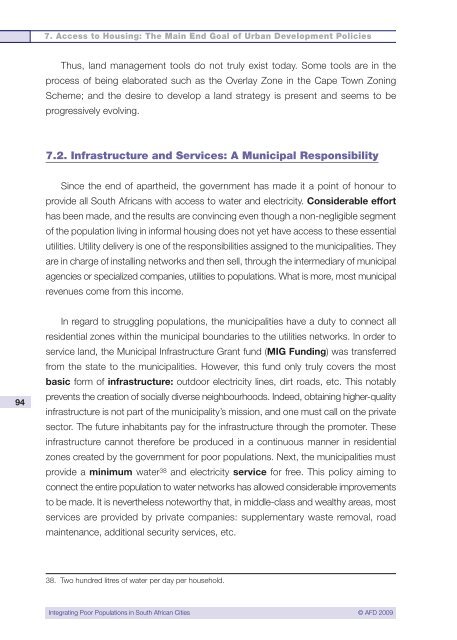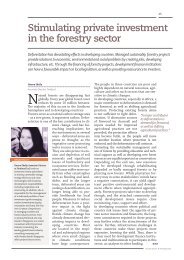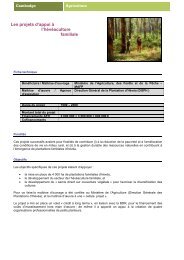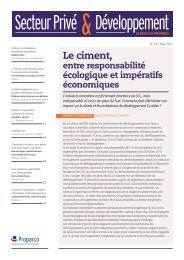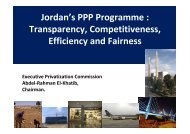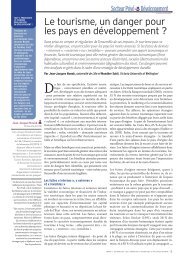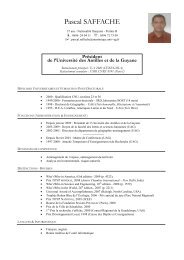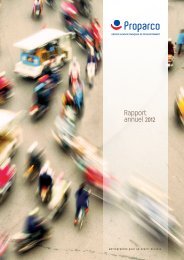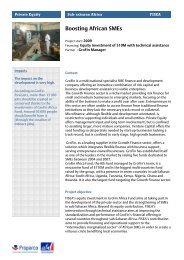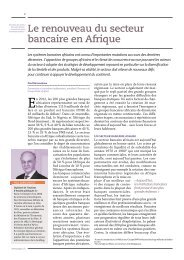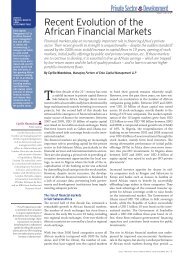Integrating Poor Populations in South African Cities - Agence ...
Integrating Poor Populations in South African Cities - Agence ...
Integrating Poor Populations in South African Cities - Agence ...
You also want an ePaper? Increase the reach of your titles
YUMPU automatically turns print PDFs into web optimized ePapers that Google loves.
7. Access to Hous<strong>in</strong>g: The Ma<strong>in</strong> End Goal of Urban Development Policies<br />
Thus, land management tools do not truly exist today. Some tools are <strong>in</strong> the<br />
process of be<strong>in</strong>g elaborated such as the Overlay Zone <strong>in</strong> the Cape Town Zon<strong>in</strong>g<br />
Scheme; and the desire to develop a land strategy is present and seems to be<br />
progressively evolv<strong>in</strong>g.<br />
7.2. Infrastructure and Services: A Municipal Responsibility<br />
S<strong>in</strong>ce the end of apartheid, the government has made it a po<strong>in</strong>t of honour to<br />
provide all <strong>South</strong> <strong>African</strong>s with access to water and electricity. Considerable effort<br />
has been made, and the results are conv<strong>in</strong>c<strong>in</strong>g even though a non-negligible segment<br />
of the population liv<strong>in</strong>g <strong>in</strong> <strong>in</strong>formal hous<strong>in</strong>g does not yet have access to these essential<br />
utilities. Utility delivery is one of the responsibilities assigned to the municipalities. They<br />
are <strong>in</strong> charge of <strong>in</strong>stall<strong>in</strong>g networks and then sell, through the <strong>in</strong>termediary of municipal<br />
agencies or specialized companies, utilities to populations. What is more, most municipal<br />
revenues come from this <strong>in</strong>come.<br />
94<br />
In regard to struggl<strong>in</strong>g populations, the municipalities have a duty to connect all<br />
residential zones with<strong>in</strong> the municipal boundaries to the utilities networks. In order to<br />
service land, the Municipal Infrastructure Grant fund (MIG Fund<strong>in</strong>g) was transferred<br />
from the state to the municipalities. However, this fund only truly covers the most<br />
basic form of <strong>in</strong>frastructure: outdoor electricity l<strong>in</strong>es, dirt roads, etc. This notably<br />
prevents the creation of socially diverse neighbourhoods. Indeed, obta<strong>in</strong><strong>in</strong>g higher-quality<br />
<strong>in</strong>frastructure is not part of the municipality’s mission, and one must call on the private<br />
sector. The future <strong>in</strong>habitants pay for the <strong>in</strong>frastructure through the promoter. These<br />
<strong>in</strong>frastructure cannot therefore be produced <strong>in</strong> a cont<strong>in</strong>uous manner <strong>in</strong> residential<br />
zones created by the government for poor populations. Next, the municipalities must<br />
provide a m<strong>in</strong>imum water 38 and electricity service for free. This policy aim<strong>in</strong>g to<br />
connect the entire population to water networks has allowed considerable improvements<br />
to be made. It is nevertheless noteworthy that, <strong>in</strong> middle-class and wealthy areas, most<br />
services are provided by private companies: supplementary waste removal, road<br />
ma<strong>in</strong>tenance, additional security services, etc.<br />
38. Two hundred litres of water per day per household.<br />
<strong>Integrat<strong>in</strong>g</strong> <strong>Poor</strong> <strong>Populations</strong> <strong>in</strong> <strong>South</strong> <strong>African</strong> <strong>Cities</strong> © AFD 2009


